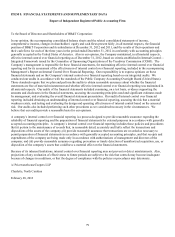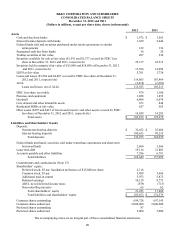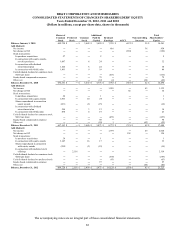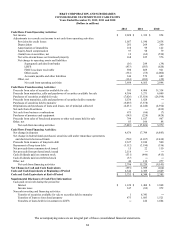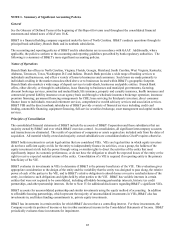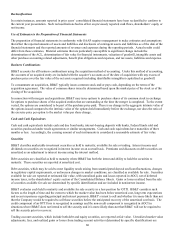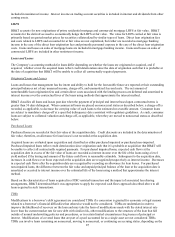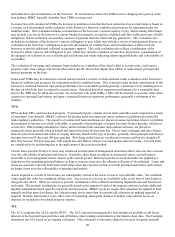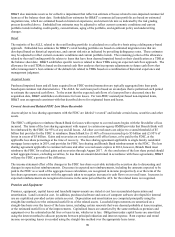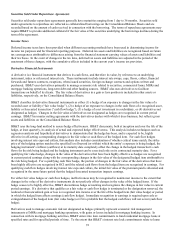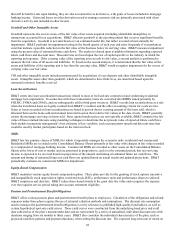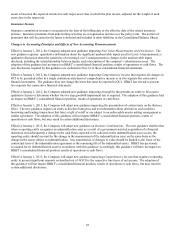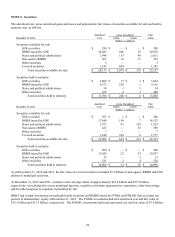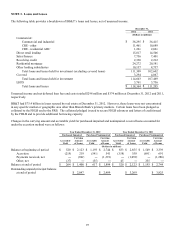BB&T 2012 Annual Report Download - page 110
Download and view the complete annual report
Please find page 110 of the 2012 BB&T annual report below. You can navigate through the pages in the report by either clicking on the pages listed below, or by using the keyword search tool below to find specific information within the annual report.88
individual facts and circumstances of the borrower. In circumstances where the TDR involves charging off a portion of the
loan balance, BB&T typically classifies these TDRs as nonaccrual.
In connection with commercial TDRs, the decision to maintain a loan that has been restructured on accrual status is based on
a current, well documented credit evaluation of the borrower’ s financial condition and prospects for repayment under the
modified terms. This evaluation includes consideration of the borrower’ s current capacity to pay, which among other things
may include a review of the borrower’ s current financial statements, an analysis of global cash flow sufficient to pay all debt
obligations, and an evaluation of secondary sources of payment from the client and any guarantors. This evaluation also
includes an evaluation of the borrower’ s current willingness to pay, which may include a review of past payment history, an
evaluation of the borrower’ s willingness to provide information on a timely basis, and consideration of offers from the
borrower to provide additional collateral or guarantor support. The credit evaluation also reflects consideration of the
borrower’ s future capacity and willingness to pay, which may include evaluation of cash flow projections, consideration of
the adequacy of collateral to cover all principal and interest and trends indicating improving profitability and collectability of
receivables.
The evaluation of mortgage and consumer loans includes an evaluation of the client’ s debt to income ratio, credit report,
property value, loan vintage, and certain other client-specific factors that impact their ability to make timely principal and
interest payments on the loan.
Nonaccrual TDRs may be returned to accrual status based on a current, well-documented credit evaluation of the borrower’ s
financial condition and prospects for repayment under the modified terms. This evaluation must include consideration of the
borrower’ s sustained historical repayment performance for a reasonable period (generally a minimum of six months) prior to
the date on which the loan is returned to accrual status. Sustained historical repayment performance for a reasonable time
prior to the TDR may be taken into account. In connection with retail TDRs, a NPL will be returned to accruing status when
current as to principal and interest and upon a sustained historical repayment performance (generally a minimum of six
months).
NPAs
NPAs include NPLs and foreclosed property. Foreclosed property consists of real estate and other assets acquired as a result
of customers’ loan defaults. BB&T’ s policies for placing loans on nonaccrual status conform to guidelines prescribed by
bank regulatory authorities. The majority of commercial loans and leases are placed on nonaccrual status when it is probable
that principal or interest is not fully collectible, or generally when principal or interest becomes 90 days past due, whichever
occurs first. Other lending subsidiaries’ loans, which includes both consumer and commercial loans, are placed on
nonaccrual status generally when principal and interest becomes 90 days past due. Direct retail, mortgage and sales finance
loans are placed on nonaccrual status at varying intervals, based on the type of product, generally when principal and interest
becomes between 90 days and 180 days past due. Revolving credit loans are not placed on nonaccrual but are charged off
after they become 150 days past due, with unpaid fees and finance charges reversed against interest income. Covered loans
are considered to be performing due to the application of the accretion method.
Certain loans past due 90 days or more may remain on accrual status if management determines that it does not have concern
over the collectibility of principal and interest. Generally, when loans are placed on nonaccrual status, accrued interest
receivable is reversed against interest income in the current period. Interest payments received thereafter are applied as a
reduction to the remaining principal balance as long as concern exists as to the ultimate collection of the principal. Loans and
leases are generally removed from nonaccrual status when they become current as to both principal and interest and concern
no longer exists as to the collectability of principal and interest.
Assets acquired as a result of foreclosure are subsequently carried at the lower of cost or net realizable value. Net realizable
value equals fair value less estimated selling costs. Any excess of cost over net realizable value at the time of foreclosure is
charged to the ALLL. NPAs are subject to periodic revaluations of the collateral underlying impaired loans and foreclosed
real estate. The periodic revaluations are generally based on the appraised value of the property and may include additional
liquidity adjustments based upon the expected retention period. BB&T’ s policies require that valuations be updated at least
annually and that upon foreclosure, the valuation must not be more than six months old, otherwise an updated appraisal is
required. Routine maintenance costs, other costs of ownership, subsequent declines in market value and net losses on
disposal are included in foreclosed property expense.
ACL
The ACL comprises the ALLL and the RUFC. The ACL represents management’ s best estimate of probable credit losses
inherent in the loan and lease portfolios and off-balance sheet lending commitments at the balance sheet date. The Company
determines the ACL based on an ongoing evaluation. This evaluation is inherently subjective because it requires material



